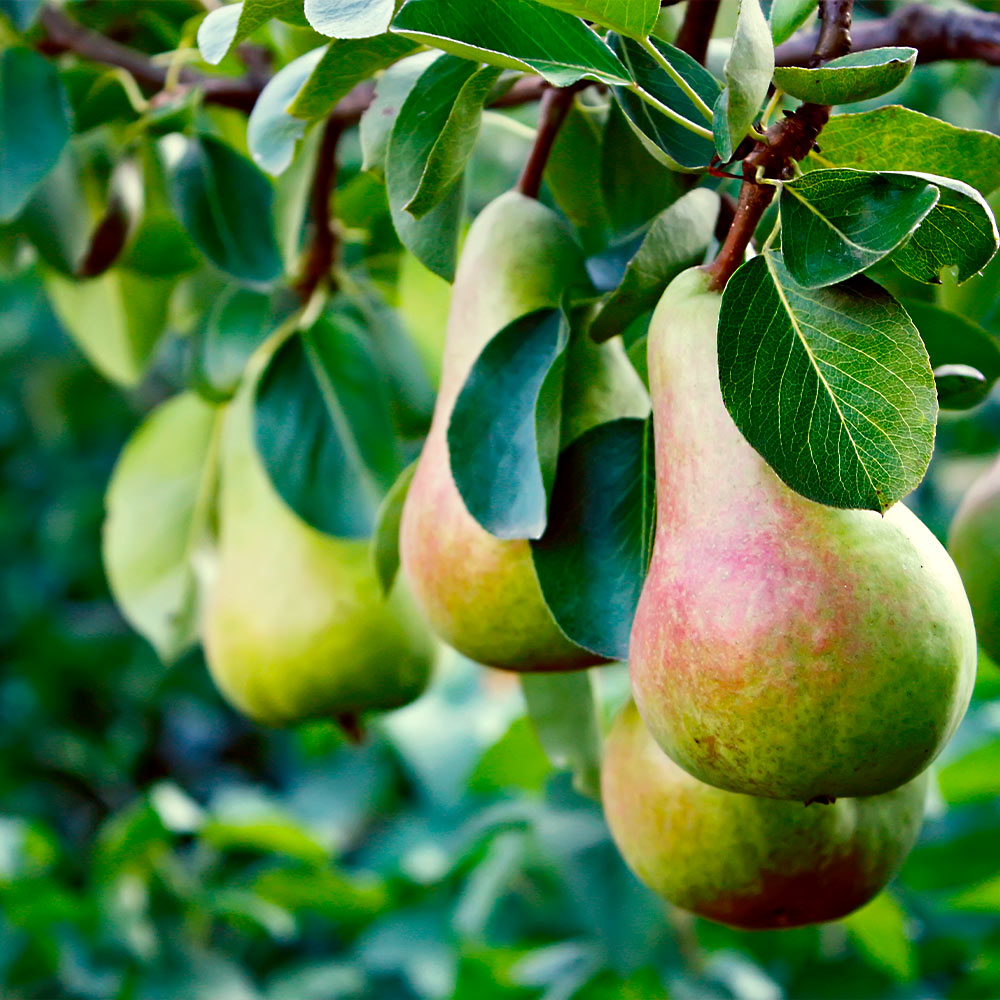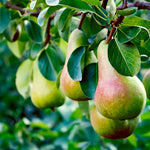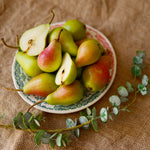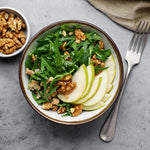Summercrisp Pear Tree Pyrus communis 'Summercrisp'

Summercirsp pears ripen in August, earlier than other pears.



* Images shown are of mature plants
Summercrisp Pear Tree Pyrus communis 'Summercrisp'
Product Description
A Pear Tree So Cold-Hardy That It Even Grows in Alaska!
A pear tree that can handle winter temperatures of minus 30 degrees F and still bear fruit the following summer is a rare find. But that's exactly what you can expect from Summercrisp Pear (Pyrus communis 'Summercrisp'). In fact, according to the University of Alaska, the original Summercrisp tree withstood a temperature of minus 35 degrees and still produced fruit! But you're not just planting a pear tree that can handle cold weather, because the Summercrisp Pear is also exceptionally flavorful. And isn't that ultimately what you want from a pear tree '– delicious fruit?
Exceptional Cold Hardiness
Even though Summercrisp Pear trees are hardy across USDA Plant Hardiness Zones 4 through 8, they are particularly suited to cold climates across the upper regions of the U.S., including Idaho, Maine, Montana, Vermont, Wisconsin, and Minnesota. This resilient and prolific pear tree made its appearance in 1933 as a result of the University of Minnesota's Fruit Breeding program, where it was subjected to rigorous testing and field trials before being introduced commercially in 1985. The University of Minnesota still refers to Summercrisp Pear as "the hardiest pear" they've ever released through their pear breeding program.
A Pear with a Sweet Crunch
Summercrisp Pears are a type of European pear, which are the pears commonly sold at grocery stores. Most European pears are described as having a "melting texture," which means that as they ripen, they become very soft with a melt-in-your-mouth feel. But European pears also have a distinctive grittiness to their texture. Summercrisp is a different kind of European pear. It has a firm texture that's crunchy when you bite into it, similar to an apple or an Asian pear. If you're not a fan of soft pears, you will love the firmness and sweet flavor of Summercrisp Pears.
Pure White Flowers That Bloom in Spring
A mature Summercrisp Pear tree in full bloom will light up your entire landscape! A cloud of white flowers fill each tree's canopy to add a brilliant ornamental touch to your springtime landscape. Although you won't be buying this pear tree simply because of its spectacular spring flowers, you'll be delighted when you see this extra little bonus!
Landscape design tip: Plant a row of pear trees along your property line for a breathtaking spring floral show!
Get a Summer Harvest of Pears Before Other Varieties
Summercrisp Pears are often ready to harvest a month ahead of other fruiting pear trees. Unlike other firm-flesh pears (such as Asian varieties), which are typically round, crunchy Summercrisp Pears have that familiar pear shape. The fruits are 3 to 4 inches long, and they are beautifully colored '– green with a red blush. They taste best when you harvest them while they're still firm and have this coloration. If you wait until the green begins to turn yellow, they'll lose their crispy crunch and their texture becomes gritty.
Long Storage Time after Harvest
Summercrisp Pears taste best right off the tree! The pears that you don't eat immediately after harvest should be refrigerated as soon as you pick them so they keep their sweetness, crispness, and juiciness. They don't hold well as a canned fruit, but their long storage life under refrigeration '– up to 2 months '– ensures that you'll enjoy lots of pears long after harvest season is over!
A Deliciously Healthy Fruit
You'll reap a harvest of nutrition from your Summercrisp Pears. Each fruit is fat-free, sodium-free, and cholesterol-free. And you'll get 24 percent of your dietary fiber recommendation from only one fruit! These healthy fruits contain natural antioxidants, and Michigan State University notes that pears contain nutrients that can even help prevent cardiovascular disease and cancer.
To Prevent Browning
The cut surfaces of Summercrisp Pears can turn brown when exposed to air. So if you're preparing them, for example, to use on a fruit platter when they may not be eaten immediately, you'll want to treat them so they retain their beautiful creamy-white flesh color. You can use a packaged anti-darkening fruit product, following the label directions. Or you can simply toss your sliced or diced Summercrisp Pears with the juice of an acidic fruit, such as pineapple, orange, or lemon. If you're making a mixed-fruit salad, prepare your acidic fruits first, such as tangerines, oranges, or pineapple, and then toss Summercrisp Pears with the other fruits to coat their cut surfaces with the acidic fruit juice.
Pollen Partner Trees
Pear trees are able to set fruit when they are cross-pollinated by a different variety of pear tree that's planted nearby. Without this "pollen partner," your Summercrisp Pear tree may bloom beautifully in springtime, but the flowers won't be fertilized, which is what sets in motion the formation of fruit. So plant a second pear tree in addition to Summercrisp '– a different cultivar '– for maximum fruit set on both of them.
Tip: Plant partner trees within 20 feet of each other to maximize their pollen exchange and increase their harvest potential.
Better Disease Resistance than Other Pear Trees
Pear trees are notoriously susceptible to a bacterial disease called fire blight, but Summercrisp is refreshingly resistant to this disease! In fact, when Summercrisp Pear trees were tested by the University of Minnesota, they showed no fire blight symptoms ?… during 20 years of field trials. And they were intentionally placed in the same area where infected trees were growing, specifically to test their level of resistance to this disease. The University's research team even noted that Summercrisp Pear trees showed no symptoms of disease or insect damage, even when pesticides weren't used.
A Little Chill for a Lot of Pears
Pear trees require a certain number of "chill hours" each year before they can successfully bear fruit. This requirement is determined by how many annual hours the temperature drops below 45 degrees F. A quick phone call to your local Cooperative Extension Service will reveal the number of chill hours in your location. Summercrisp Pear trees need approximately 800 chill hours to produce fruit.
Caring for Your Tree
A healthy Summercrisp Pear tree is one that bears prolifically and resists disease. Here are some guidelines to keep your tree in optimal health:
• Sun. Plant your Summercrisp Pear in a full-sun location to maximize its fruiting potential.
• Soil. Summercrisp is highly adaptable to different types of soil, but it prefers a slightly acid pH of 6.0-6.5.
• Planting. Dig a hole that is no deeper than the root ball of your pear tree but twice as wide. Look for the bump or area of swelling that's on the trunk above the rootball, which is where your tree was grafted. This graft union should not be planted so that it's below the soil surface. Gently loosen and spread the roots before settling your tree into its planting hole. Backfill the hole with the soil you removed, making sure that the tree is planted at the same depth in the hole as it was in the container. Gently tamp the soil around your tree, and give it a deep drink of water!
• Water. Soil that stays evenly moist is best for growing Summercrisp Pear trees. This doesn't mean wet soil; in fact, you want to make sure that the planting site you select doesn't stay boggy after rainfalls or irrigation sessions. Pear trees don't tolerate standing water, which can cause their roots to rot and may ultimately cause the death of trees. After you plant your Summercrisp Pear, keep it watered well until it becomes established.
• Fertilizer. You don't have to worry about fertilizing your Summercrisp Pear the first year after you plant it. In fact, too much fertilizer during this time can actually burn your tree's developing roots. The year after planting '– in springtime '– follow the recommendations of a soil test to know how much and what kind of fertilizer your tree needs.
Tip: Your local Cooperative Extension Service can perform a soil test to determine your soil's pH and fertility needs for your Summercrisp Pear tree.
The Many Benefits of Mulch
Applying a 3- to 4-inch layer of mulch around your Summercrisp Pear tree has multiple benefits:
• It helps moderate the soil temperature around the roots.
• It protects the trunk and roots from mower and string-trimmer damage.
• It helps conserve moisture that would otherwise be lost to evaporation.
• It helps suppress weeds.
• In extremely cold climates, the simple addition of mulch can help prevent your tree from heaving out of the ground during spring thaws.
Shipping Details
Estimated Shipping Time: Most orders ship within 1-2 days. As noted on the website, some items are seasonal, and may only ship in spring or fall. Once your order is shipped, you'll receive an email with a tracking number.
| Order Total | Shipping Charges |
|---|---|
| Less than $100 | $24.95 |
| $100.00-$128.99 | $29.95 |
| $129 + | FREE SHIPPING! |
Product Details
Growing Zones: 4-8 outdoors
 4-8 outdoors
(hardy down to -20℉)
4-8 outdoors
(hardy down to -20℉)
- Mature Height: 18-25 ft.
- Mature Width: 10-20 ft.
- Sunlight: Full Sun
- Spacing: 20 ft.
- Growth Rate: 1 ft.
- Does Not Ship To: AZ, AR, CA, ID, LA, WA
Customer Reviews & Photos





